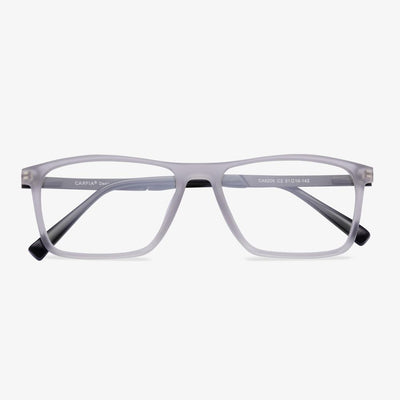Optical Stores Provide Customer Experience
Traditional single product marketing has been far from meeting the needs of customers. It is necessary to apply practical artistic aesthetics to the decoration design of physical eyewear stores, product packaging, and marketing planning, to increase customers' experience of the store, increase store goodwill, brand memory, interest in the product, and stimulating customers' consumption. In reality, most eyewear retail stores are making great efforts in product selection, product display, consumer experience, marketing activities, service methods, and other aspects. For example, the introduction of themed display scenes in traditional optical stores, the layout of bricks-and-mortar stores of e-commerce to increase consumer service experience, and so on have achieved good results.
Full-frame glasses
Full-rimed Glasses are now commonly used, which can make the lens fixed, with good protection of glasses. They are firm and easy to finalize the design, with strong hardness. Full-rim glasses frame is in the majority with plank material. The style is sporty and stylish, which is pursued by young people nowadays. Full-frame glasses are of different styles, rich colors, and can mask part of the lens thickness. The beautiful extent is very good, so are loved by many people with slightly higher degrees.
Material selection
General glasses material has plastic and metal two categories. Because the children's glasses degrees change faster, from the economic point of view, choosing plastic material is more affordable. And children love to move, they do not pay much attention to pick up and put on glasses. Choosing metal material is easy to distort, affecting the normal wearing. The material of the lens should be light and thin. The transmittance and refractive index should be high, and it should be wear-resistant and not easy to break.
Eyeglasses chain stores have unified standards.
Due to the different management systems, the traditional business mainly relies on differentiated management and it enables member enterprises to have different business scope and modes and form complimentary benefits. Often, member enterprises are not required to implement unified management, with the unclear division of labor and uncertain responsibilities. The main store of a chain store and other stores shall form a clear division of labor in their professional functions, requiring the implementation of a unified management system, unified purchase, unified operation, and unified management. All the stores under the jurisdiction implement the unified management norm form formulated by the headquarters to form a unified norm.
Sales points of note for color changing lens
The discoloration rate of the lens is related to the intensity of ultraviolet light. The stronger the ultraviolet light is, the faster the discoloration rate will be, while the vice versa. The degree of discoloration is related to the ambient temperature. The higher the temperature is, the color of the lens is slightly lighter. Otherwise, the color is slightly darker. With the progress of manufacturing technology, the discoloration rate, especially the fading rate of the discoloration lens has been greatly improved, and the interference of temperature on the color depth is becoming less and less. Either glass or resin lenses react only with ultraviolet light, not visible light, so in some environments, they do not darken.
Who need progressive lenses?
There is no limit to the degree of progressive multifocal lenses. Whether it is nearsightedness, presbyopia or moderate astigmatism, it can be worn, but not everyone can wear it. There are two types of progressive multifocal lenses on the market, one is hard and the other is soft. The main difference between the two designs is the length of the progressive channel. The rigidly designed progressive film has a short progressive path and relatively less peripheral aberrations. In order to ensure vision at various distances, fewer vertical dimensions are required. For example, a teenage progressive film belongs to this design, but because of its short gradual path, the gradation process is too short. Fast. Compared with the elderly, this design is more difficult to adapt; the soft design of the progressive film has a relatively long gradation channel and relatively large peripheral aberrations, but due to its long gradation channel, the gradation process is relatively smooth, which makes it easy to wear glasses It is suitable for people with poor adaptability.
If you are a person who is able and willing to accept new things, understand and adapt to the temporary discomfort caused by progressive addition lenses, we suggest that he can wear a pair, if he has severe hypertension, dizziness and other symptoms, or People who have misunderstandings about progressive lenses and are unwilling to adapt should not try them. Because you first wear progressive multifocal glasses, you may experience: slight dizziness, shaking when walking, and being careful when moving up the stairs.
The perception of space has changed, the perception of the distance of the object, and the perception of depth have changed. New wearers should not drive immediately and do strenuous exercise. When you look close, you need to turn your eyes down, and your eyes are mildly uncomfortable. Seeing an object through the blurred vision area around the lens makes the object blurred. Therefore, when new wearers look at things, turn their heads more, turn their eyes less, try to use the far-use zone, the near-use zone, and the middle-distance zone to see objects.
Method of wearing the contact lens
Wash your hands before putting on contact lenses, and be careful not to leave long nails, to avoid contamination of the lens by bacteria and nail scratches. Place the contact lens on the tip of your index finger, face-up, and pull your upper and lower eyelids apart with the middle fingers of both hands. Look straight ahead and place the lens gently into the eye (attached to the cornea). Remove the index finger and look down so that the lens is attached to the cornea, and slowly relax the eyelids with the middle fingers of both hands. Blink gently several times (or roll your eyes) to remove bubbles.











































